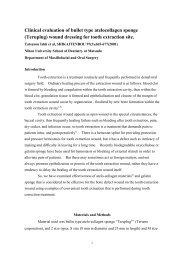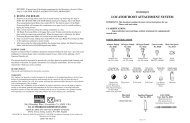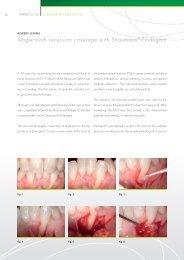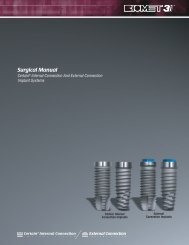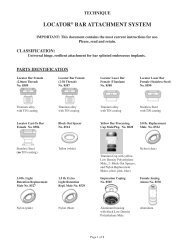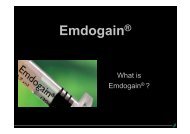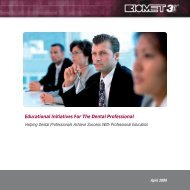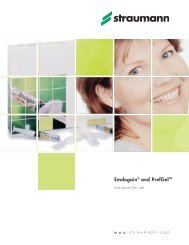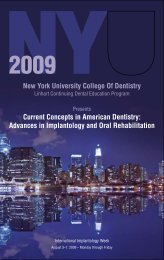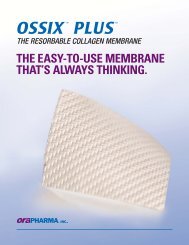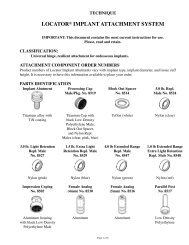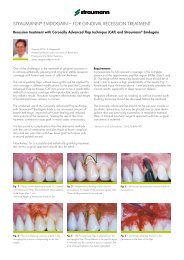Research Dossier
Research Dossier
Research Dossier
- No tags were found...
You also want an ePaper? Increase the reach of your titles
YUMPU automatically turns print PDFs into web optimized ePapers that Google loves.
Overview: Studies In ProgressHuman Clinical StudiesFully Edentulous Maxilla – Study 2607 is a prospective,randomized-controlled study of fully edentulous maxillapatients where cases will be randomly assigned to receiveeither the NanoTite or OSSEOTITE ® Surface Implant. Thestudy will assess the integration success and duration offailure-free function of all implants to determine if theNanoTite Surface enhancement can improve performance infully edentulous maxillary cases.Placement In Augmented Bone – Study 2604 is aprospective, randomized-controlled comparison of NanoTitePREVAIL ® Implants used in sinus lift augmentation sites. Thegoal of this multicenter study is to determine if the NanoTiteSurfaced Implants placed simultaneously with the sinusaugmentation graft material have the same success outcomesas do NanoTite Implants placed into healed sinusaugmentation grafts. When this is established, there will bethe opportunity to avoid four months of delay in functionalizingsuch sinus augmentation cases.Immediate Replacement In Extraction Sites – Study2605 is a prospective, randomized-controlled study ofpatients with multiple tooth extractions where at least twosites will be randomly assigned to receive either the NanoTiteor OSSEOTITE Surface PREVAIL Implant. The study willassess the integration success and duration of failure-freefunction of all implants to determine if the NanoTite Surfaceenhancement can improve performance in these morechallenging cases.Sinus Augmentation Avoidance Trials – Studies 2611and 2612 will utilize a 7mm length NanoTite Surface Implant(actual length – other “short implants are actually 7mm orlonger) to be used in thin maxillary cases where a sinusaugmentation (and standard length implants) would beutilized. In addition to assessing integration and duration offailure-free performance of these short implants, a specificeffort will be made to quantify the amount of resources(clinician and patient time and discomfort, surgical costs,materials costs) that can be preserved by obviating the needfor an augmentation surgery.Clinical Comparisons Of NanoTite Vs. OSSEOTITEHistomorphometric Outcomes –University G. d’Annunzio, Chieti-Pescara University, ItalyMiniplants of 2mm diameter and 10mm length are placed inthe posterior maxilla at sites that will later receive clinicalimplants are retrieved after about two months healing andsubjected to histological analysis of bone-to-implant contact.NanoTite and OSSEOTITE Surfaced Miniplants are placed inthe same patient to provide patient-controlled outcomes.Results of this accepted for presentation at the upcomingAcademy of Osseointegration 2007 Symposia in San Antonio.Biomaterials Clinical <strong>Research</strong> Association, Pescara, ItalyNanoTite and OSSEOTITE Surfaced Miniplants placed in theposterior maxilla and retrieved after two months healing areprocessed for histological analysis of bone-to-implant contact.Animal Pre-Clinical StudiesSoft And Hard Tissue Analysis Of NanoTite AndOSSEOTITE Implant Surfaces –The Sahlgrenska Academy at Göteborg UniversityEight implant sites in each of six canine animals are randomlyassigned to receive either NanoTite or OSSEOTITETransgingival Implants where the surfaces extend from theapex to the coronal seating platform. After two and fourweeks of healing, the interfacial tissues are examined byground section and by a fractionation method that allowsobservation of microcellular structures.Soft And Hard Tissue Analysis Of NanoTite AndOSSEOTITE Implant Surfaces –A collaborative research effort of the Universities of Madrid,Sienna and GöteborgFour implant sites in each of six canine animals are randomlyassigned to receive either NanoTite or OSSEOTITE Implantsthat are placed in a single-stage manner with correspondingNanoTite and OSSEOTITE Healing abutments. After two andfour weeks of healing, the interfacial tissues are examinedby ground section and by a fractionation method that allowsobservation of microcellular structures.Implant Stability – Study 2610 is a randomized, doubleblindevaluation of the impact of a surface modification on theImplant Stability Quotient during the initial implant healingperiod. This prospective, double blind, randomized-controlledclinical study will evaluate changes in the implant stabilityquotient (ISQ) that take place within the first eight weeksfollowing implant placement in the posterior mandible andmaxilla to determine if a difference in the ISQ measurementsare detected between OSSEOTITE and NanoTite Implants.19



